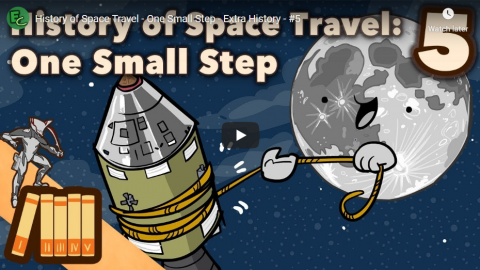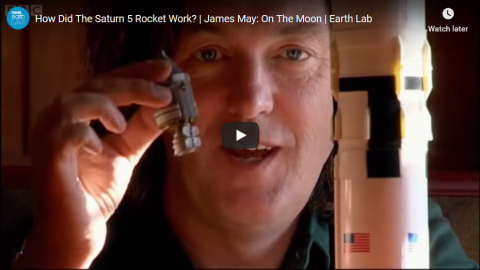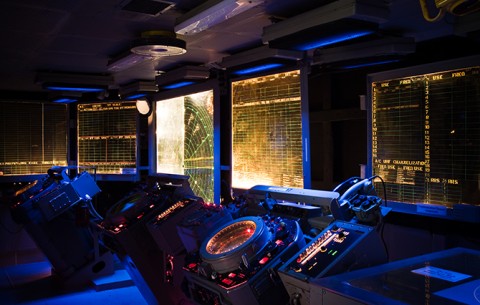Tasting History with Max Miller
Published Apr 23, 2024Smooth, sweet, and sour Tang pie in a graham cracker crust
City/Region: United States of America
Time Period: 1960sContrary to popular belief, NASA did not invent Tang, but the company that did, General Foods, used the association in a lot of their marketing. They even developed this recipe for Tang pie, also called astronaut pie.
The texture of the pie is smooth and very nice, but it had too much of a sour zip in it, or “tang” if you will, for me. If you like sour notes like in lemon meringue or key lime pies, or if you just like Tang, then I think you’ll like this. You can use a ready-made graham cracker crust to make this pie even easier to put together.
Tang Pie. It’s the pie of the future. Here it goes space boys and girls:
TANG Pie
1 can sweetened condensed milk
3/4 C. Tang® powder drink mix
1/2 C. sour cream
1 (9 oz.) tub Cool Whip®
1 graham cracker pie crust.
Mix condensed milk and Tang. Add in sour cream until well blended. Then fold in tub of Cool Whip. Pour into pie crust and refrigerate for 4 hours or until set and cold.
August 5, 2024
What the First Astronauts Ate – Food in Space
February 19, 2020
QotD: Myths the Greatest Generation believed
In addition to inflating our confidence in overseas interventions, the war era fueled belief that government could be a major force for good at home, capable of solving every domestic problem. Franklin Roosevelt’s superb wartime management boosted the popular opinion of government and encouraged Americans to adopt war as a metaphor for government action in general. The war seemed to fulfill Teddy Roosevelt’s and Woodrow Wilson’s earlier progressive dreams that big government, acting in concert with big business and big labor, could solve any problem that it chose to tackle. Just as warfare was re-envisioned to fit the total-war model of World War II, governing became understood as a matter of trained professionals applying management methods to public policy.
This belief in the military-like efficiency of government inspired the ambitious welfare-state policies of the postwar era, especially Johnson’s War on Poverty. When, in 1972, Richard Nixon declared a War on Drugs, and when, in 1977, Jimmy Carter described the energy crisis as the “moral equivalent of war,” the model they had in mind was, again, World War II. Today, newspapers and scientific journals still proclaim the need for ambitious government action to fix enormously complex problems — for example, calling repeatedly for a “new Manhattan Project” to solve the problem of climate change.
War, as conservatives figured out early on, is a poor metaphor for government doing socially useful things. We can’t fight and win a “war” on poverty, or drugs, or cancer, because these things are nothing like war. The last heroic big-government project run along World War II lines was the Apollo program, which put Americans on the moon. This was a tremendous achievement, but here a military mindset was directly relevant: like the design of war machines a quarter-century earlier, the Saturn rockets were a discrete engineering challenge, one whose basic parameters were well understood.
E. M. Oblomov, “The Greatest Generation and the Greatest Illusion: Success in World War II led Americans to put too much faith in government — and we still do.”, City Journal, 2017-12-28.
December 7, 2019
History of Space Travel – One Small Step – Extra History – #5
Extra Credits
Published 5 Dec 2019Start your Warframe journey now and prepare to face your personal nemesis, the Kuva Lich — an enemy that only grows stronger with every defeat. Take down this deadly foe, then get ready to take flight in Empyrean! Coming soon! http://bit.ly/EHWarframe
The United States was losing the space race. A number of unfortunate missteps and mistakes had hindered their progress. But the United States had also structured its space program entirely differently from the USSR. Instead of being helmed by the military, the National Aeronautics & Space Administration was created by Eisenhower with an emphasis on exploration and research. And in the end, the later but more advanced satellites will collect the data required a dream firmly placed in the American consciousness by JFK. A dream to place a man on the moon.
From the comments:
Extra Credits
19 hours ago
The plaque still gives me goosebumps in the best way possible. Hopefully one day we can live up to its promise of peace. Be good to one another.And thanks to Rebecca Ford (the voice of Lotus) for voicing space mom at the end of each of these episodes. They’ve been a blast to make and we hope that you all have enjoyed this trip to the stars.
November 6, 2019
How Did The Saturn 5 Rocket Work? | James May: On The Moon | Earth Lab
BBC Earth Lab
Published 3 Jan 2017James May meets Harrison Schmitt, one of the last men to ride Saturn 5 and learns a bit about the science behind a rocket with six million components.
Taken From James May: On the Moon
Welcome to BBC Earth Lab! Here we answer all your curious questions about science in the world around you (and further afield too). If there’s a question you have that we haven’t yet answered let us know in the comments on any of our videos and it could be answered by one of our Earth Lab experts.
July 20, 2019
50th anniversary
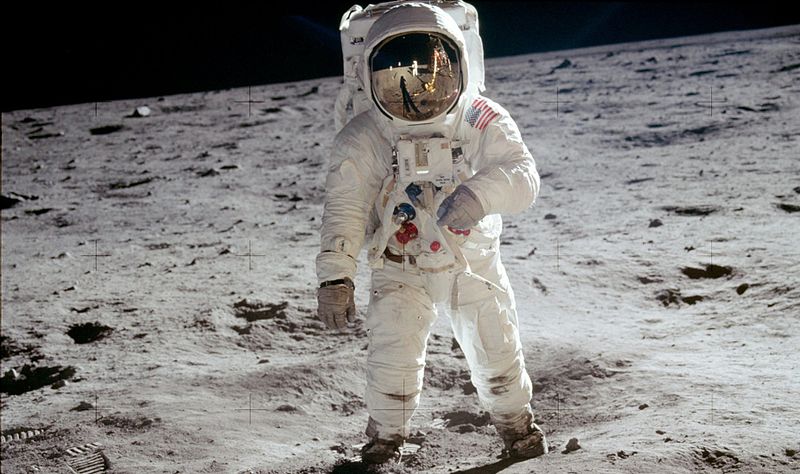
Astronaut Buzz Aldrin, lunar module pilot, stands on the surface of the moon near the leg of the lunar module, Eagle, during the Apollo 11 moonwalk. Astronaut Neil Armstrong, mission commander, took this photograph with a 70mm lunar surface camera. While Armstrong and Aldrin descended in the lunar module to explore the Sea of Tranquility, astronaut Michael Collins, command module pilot, remained in lunar orbit with the Command and Service Module, Columbia. *This is the actual photograph as exposed on the moon by Armstrong. He held the camera slightly rotated so that the camera frame did not include the top of Aldrin’s portable life support system (“backpack”). A communications antenna mounted on top of the backpack is also cut off in this picture. When the image was released to the public, it was rotated clockwise to restore the astronaut to vertical for a more harmonious composition, and a black area was added above his head to recreate the missing black lunar “sky”. The edited version is the one most commonly reproduced and known to the public, but the original version, above, is the authentic exposure.
June 26, 2019
“… what’s happening now is even better than Apollo”
At Popular Mechanics, Joe Pappalardo reminds us that the 50th anniversary of the Apollo 11 lunar landing is coming up next month, but that current developments in space are worth celebrating too:

Astronaut Buzz Aldrin, lunar module pilot, stands on the surface of the moon near the leg of the lunar module, Eagle, during the Apollo 11 moonwalk. Astronaut Neil Armstrong, mission commander, took this photograph with a 70mm lunar surface camera. While Armstrong and Aldrin descended in the lunar module to explore the Sea of Tranquility, astronaut Michael Collins, command module pilot, remained in lunar orbit with the Command and Service Module, Columbia.
Apollo was born of Cold War desperation: a political exercise that paid enormous scientific and technological dividends. After the launch of Sputnik in 1957, it became vital to beat the Soviet Union to the Moon, a geopolitical urge that created an enormous budgetary effort.
The problem with politically motivated — well, anything — is that the faucet of support can be closed just as quickly as it opened. It happened to Apollo, as follow on missions were cancelled and the focus shifted to a reusable craft to service low-earth orbit. This pattern of shifting space priorities and strategies whipsawed NASA, most noticeably when the Obama administration’s cancellation of the Bush-era Constellation moon program in 2010.
But multiple private companies pursuing their niches in space have an obvious redundancy. While companies may rise and fall, the very nature of a commercial effort isn’t as dependent on government funding. If it’s worth doing, especially if it makes money, space industry will endure political shifts. The objectives of a well-run company do not change that much every four years.
That leaves today’s NASA with a choice: Do it themselves and control everything (the traditional way), or fund private companies to develop the tech the agency needs and then allow them to sell their services to any nation, company, or individual (the new way). With those services on the open market, NASA would be one of many customers for a new U.S.-based space economy.
This debate is boiling over right now. The ongoing effort to return to the moon, called Artemis (after Apollo’s sister), is becoming a lesson in the advantages of the commercial model.
[…]
If only investment guaranteed results. For those who miss bloated, government-run spaceflight, there is already a NASA spacecraft mired in the old ways of thinking. The feds have sunk a lot of money into the Space Launch System, a mega-rocket built to NASA specs for deep space missions. It was supposed to fly in 2017, but we’ll be lucky to see a first flight in 2020 — and it busted the $9.7 billion estimated budget, now costing about $12 billion.
But something happened during these SLS delays: the commercial space industry started delivering on its promises. Most visibly, private firms have been delivering supplies to the International Space Station for years and (hopefully soon) will ferry astronauts as well. Blue Origin and SpaceX has started development of crewed spacecraft able to reach to the moon and Mars. Elon Musk even sold a moon trip to a Japanese billionaire.
March 3, 2017
“Apollo 8 altered the self-perception of our species forever”
Colby Cosh contrasts the insane bravado of John F. Kennedy’s moonshot announcement with the more recent insane bravado of Elon Musk and SpaceX:
SpaceX, the private rocketry company founded in 2002 by billionaire adventurer Elon Musk, says it is developing plans to fly two unnamed persons to the moon late in 2018. This announcement has created both skepticism and alarm. This is, I think, partly a matter of confusion about prepositions.
If I announced that, despite being Canada’s most sedentary citizen, I was going to Mount Everest next week, you would probably know better than to assume I was going UP the mountain. SpaceX’s proposal is to send a manned spacecraft beyond the moon. That’s the word they use in the SpaceX press release, and whoever chose it should get a big fat bonus. “Beyond” is an English word of unparalleled connotative power and romance.
But, of course, going beyond the moon — more prosaically, looping around it and coming back — is much, much simpler than landing ON it. It is probably not a fantastically difficult challenge, and the company’s zany-sounding timeline may be justified. (Mind you, this is not a prediction.)
Even if you are old enough to have followed the golden age of spaceflight as it happened, you may not understand or remember the half-insane ambition of John F. Kennedy’s original proposal to land men on the moon. For young and old, the moment that the Apollo 11 lunar module landed on the Sea of Tranquility tends to obscure everything else about the tale in retrospect. But no U.S. astronaut had orbited the Earth yet when JFK threw down the gauntlet. No spaceship had photographed, much less touched, the moon.
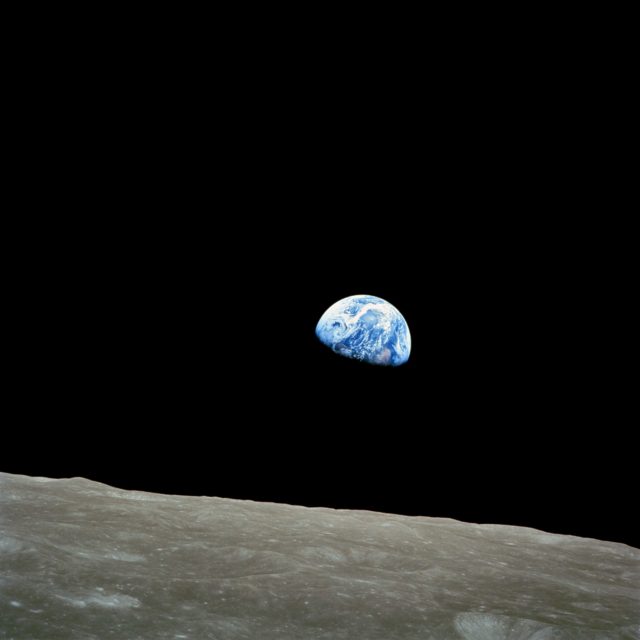
Taken by Apollo 8 crew member Bill Anders on December 24, 1968, at mission time 075:49:07 (16:40 UTC), while in orbit around the Moon, showing the Earth rising for the third time above the lunar horizon. The lunar horizon is approximately 780 kilometers from the spacecraft. Width of the photographed area at the lunar horizon is about 175 kilometers. The land mass visible just above the terminator line is west Africa. Note that this phenomenon is only visible to an observer in motion relative to the lunar surface. Because of the Moon’s synchronous rotation relative to the Earth (i.e., the same side of the Moon is always facing Earth), the Earth appears to be stationary (measured in anything less than a geological timescale) in the lunar “sky”. In order to observe the effect of Earth rising or setting over the Moon’s horizon, an observer must travel towards or away from the point on the lunar surface where the Earth is most directly overhead (centred in the sky). Otherwise, the Earth’s apparent motion/visible change will be limited to: 1. Growing larger/smaller as the orbital distance between the two bodies changes. 2. Slight apparent movement of the Earth due to the eccenticity of the Moon’s orbit, the effect being called libration. 3. Rotation of the Earth (the Moon’s rotation is synchronous relative to the Earth, the Earth’s rotation is not synchronous relative to the Moon). 4. Atmospheric & surface changes on Earth (i.e.: weather patterns, changing seasons, etc.).
NASA photo via Wikimedia.
July 21, 2014
NASA’s “random mode”
Robert Zubrin identifies two different modes of operation practiced by NASA since 1961:
Over the course of its life, NASA has employed two distinct modes of operation. The first prevailed during the period from 1961 to 1973, and may therefore be called the Apollo Mode. The second, prevailing since 1974, may usefully be called the Random Mode.
In the Apollo Mode, business is conducted as follows. First, a destination for human space flight is chosen. Then a plan is developed to achieve the objective. Following this, technologies and designs are developed to implement the plan. These designs are then built, after which the mission is flown.
The Random Mode operates entirely differently. In this mode, technologies and hardware elements are developed in accord with the wishes of various technical communities. These projects are then justified by arguments that they might prove useful at some time in the future when grand flight projects are once again initiated.
Contrasting these two approaches, we see that the Apollo Mode is destination-driven, while the Random Mode pretends to be technology-driven but is actually constituency-driven. In the Apollo Mode, technology development is done for mission-directed reasons. In the Random Mode, projects are undertaken on behalf of various internal and external technical-community pressure groups and then defended using rationales (not reasons). In the Apollo Mode, the space agency’s efforts are focused and directed. In the Random Mode, NASA’s efforts are scatterbrained and entropic.
Imagine two couples, each planning to build their own house. The first couple decides what kind of house they want, hires an architect to design it in detail, then acquires the appropriate materials to build it. That is the Apollo Mode. The second couple canvasses their neighbors each month for different spare house-parts they would like to sell, and buys them all, hoping to eventually accumulate enough stuff to build a house. When their relatives inquire as to why they are accumulating so much junk, they hire an architect to compose a house design that employs all the miscellaneous items they have purchased. The house is never built, but an adequate excuse is generated to justify each purchase, thereby avoiding embarrassment. That is the Random Mode.
NASA had an overriding mission from 1961 to 1974: the moon program. Almost all of its resources were devoted to that goal, and it was achieved. Then bureausclerosis set in, politics took over, and we left the moon (so far, for good). If the future of mankind is in space, it’s unlikely that NASA will be a significant part of that future (unless you count its role in working to hold back private enterprise from getting involved on NASA’s “turf” (can I call it “astroturf” in this context?)).
July 20, 2014
Apollo 11 moon landing anniversary
The first men walked on the moon on this day in 1969:

Astronaut Buzz Aldrin, lunar module pilot, stands on the surface of the moon near the leg of the lunar module, Eagle, during the Apollo 11 moonwalk. Astronaut Neil Armstrong, mission commander, took this photograph with a 70mm lunar surface camera. While Armstrong and Aldrin descended in the lunar module to explore the Sea of Tranquility, astronaut Michael Collins, command module pilot, remained in lunar orbit with the Command and Service Module, Columbia. *This is the actual photograph as exposed on the moon by Armstrong. He held the camera slightly rotated so that the camera frame did not include the top of Aldrin’s portable life support system (“backpack”). A communications antenna mounted on top of the backpack is also cut off in this picture. When the image was released to the public, it was rotated clockwise to restore the astronaut to vertical for a more harmonious composition, and a black area was added above his head to recreate the missing black lunar “sky”. The edited version is the one most commonly reproduced and known to the public, but the original version, above, is the authentic exposure.
I didn’t realize that almost all the Apollo 11 photographs of astronauts are of Buzz Aldrin. For some reason, Neil Armstrong appears in only a few of them, and The Atlantic‘s Rebecca Rosen wonders why:
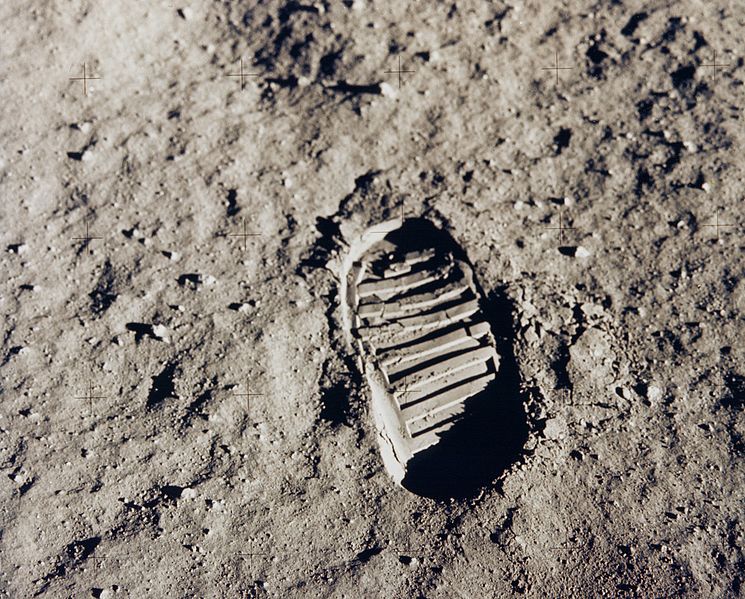
Bootprint in lunar dust created and photographed by Buzz Aldrin for the boot penetration (soil mechanics) task during the Apollo 11 moon walk.
If there is one thing everybody knows about Neil Armstrong, it is this: “One small step for [a] man, one giant leap for mankind.” This quotation, in my mind at least, appears illustrated, conjuring the image above of an imprint left by a human boot upon the dusty lunar surface.
Except that’s not the first step, nor was it left by Armstrong. It’s a footprint made by Buzz Aldrin, the second man to walk on the moon.
[…]
The explanation for this paucity is murky at best, prone to the uncharitable reading that Aldrin was getting “Armstrong back by taking no photographs of him on the Moon” in retribution for Armstrong getting the honor of first to set foot on the lunar surface.
But this is speculation at best. Aldrin, at least, has always said that the lapse was inadvertant, the result of Armstrong carrying the camera most of the time, a picture of Armstrong not appearing on the bucket list of things to do while on the moon, and Armstrong never stopping to ask for one. According to Aldrin, he was about to take a picture of Armstrong at the flag ceremony when President Nixon called, distracting them from the task.
[…]
Later, Aldrin expressed regret about the oversight. “When I got back and someone said, ‘There’s not any of Neil,’ I thought, ‘What in the hell can I do now?’ I felt so bad about that. And then to have somebody say that might have been intentional…. How do you come up with a nonconfrontational argument against that? I mean, that was just such a divisive observation, and Neil and I were never in the least divisive. We really were intimidated by the situation we found ourselves in on the Moon, hesitant and with an unclear idea of what to do next.”
Hansen’s book includes a handful of divergent opinions from different NASA administrators, theorizing as to how this, what Hansen calls “one of the minor tragedies of Apollo 11,” could have happened. Was it mere oversight or petty payback? Men sticking close to the plan or men sticking too close to the plan?
H/T to Colby Cosh:
This quirk of history is usually covered as if it were, or even could have been, the astronauts’ fault. It’s a bit unfortunate.
— Colby Cosh (@colbycosh) July 20, 2014
January 23, 2013
How easy would it be to fake the 1969 Apollo 11 moon landing?
H/T to Kathy Shaidle, who writes:
Remember: Conspiracy theories are history for stupid people. They provide idiots with the thrilling sensation that they’re smarter than everyone else, and are a seductive distraction from real problems.
As the (liberal) filmmaker says:
“They lead you to sell your soul for the comfort of being a rebel.”
That’s what Satan did.
December 14, 2012
40 years ago today, man last walked on the moon
At sp!ked, Patrick West notes an under-observed anniversary:
It is a fine testament to NASA’s Apollo programme that of all the world-shaking events in living memory, men landing on the moon is the only one that doesn’t involve death. As Andrew Smith, author of Moon Dust (2006), notes, everyone remembers where they were when John F Kennedy was assassinated, Princess Diana died, or on 9/11. Most people, if they were alive at the time, also vividly recall when a man first walked on the moon on 20 July 1969.
Few, however, will remember what they were doing when the last man walked on the moon. That was 40 years ago today.
As he fired up the engines of Apollo 17‘s Lunar Module, Gene Cernan, the last man on the moon, delivered a final message to the world: ‘America’s challenge has forged man’s destiny of tomorrow. And as we leave the moon at Taurus-Littrow, we leave as we came and, God willing, as we shall return with peace and hope for all mankind.’ On this date, many of us lament that we haven’t gone back to the moon. Others won’t, citing the vast expense of this Cold War sideshow, equivalent to roughly $130 billion in today’s money.
We certainly aren’t likely to return to the moon in such cynical and pessimistic times, of Mayan prophecies, omens of economic stagnation and environmental catastrophe, Frankie Boyle misanthropy and books called Is It Just Me Or Is Everything Shit?. In other words, everything the Apollo programme didn’t represent. America’s race to the moon may have been partly a means of getting one over the Soviets, but it also embodied the spirit of adventure and progress, as encapsulated by Neil Armstrong’s first words from the moon.
August 27, 2012
Restarting the age of space
sp!ked reposted an older article by James Woudhuysen on the long-term importance of space exploration and the stay-at-home attitudes that oppose further development of the “final frontier”:
One thing unites the critics of lunar exploration. Forty years after man first landed on the moon — on 20 July 1969 — they share a disdain for the grandeur of extra-terrestrial endeavour; for the scale of human ambition involved; for the very idea that human beings should climb into space, as up a mountain, ‘because it is there’.
I have no special preference for size, thrust during lift-off, or the traverse across vast distances. The development of the integrated circuit in the late 1950s, so important to the Apollo programme, was a tribute to miniaturisation rather than to high energy or physical scale. No, my admiration for both Saturn boosters and tiny electronics grows from a respect for open-ended curiosity, for human achievement, and for taking risks. With space travel, a lot of bravery was also at stake. And with both space and the development of semiconductors, there is much teamwork to celebrate — teamwork that, in the case of Apollo, involved not just three astronauts, but the efforts of hundreds of thousands of people.
[. . .]
August 26, 2012
Neil Armstrong, RIP
From Buzz Aldrin, an official statement on the death of Neil Armstrong:
I am deeply saddened by the passing of my good friend, and space exploration companion, Neil Armstrong today. As Neil, Mike Collins and I trained together for our historic Apollo 11 Mission, we understood the many technical challenges we faced, as well as the importance and profound implications of this historic journey. We will now always be connected as the crew of the Apollo 11 mission to the moon, yet for the many millions who witnessed that remarkable achievement for humankind, we were not alone.
Whenever I look at the moon I am reminded of that precious moment, over four decades ago, when Neil and I stood on the desolate, barren, yet beautiful, Sea of Tranquility, looking back at our brilliant blue planet Earth suspended in the darkness of space, I realized that even though we were farther away from earth than two humans had ever been, we were not alone. Virtually the entire world took that memorable journey with us. I know I am joined by many millions of others from around the world in mourning the passing of a true American hero and the best pilot I ever knew. My friend Neil took the small step but giant leap that changed the world and will forever be remembered as a historic moment in human history.
August 23, 2010
QotD: Peak Culture
The height of their society peaked in 1969. They used militarism and socialism to put two guys on the Moon, they trotted out their public-private partnership (Concorde) to build exclusive supersonic transport for the rich. Max Faget and some other brilliant engineers designed a space shuttle fleet of ten vehicles capable of hundreds of flights a year to make access to low Earth orbit cheap and routine. And the Advanced Research Projects Agency had some geeks create an inter-networking protocol that could survive a nuclear war.
Obviously, they shot their wad, as it were, and no longer put guys on the Moon. They no longer fly supersonic transports. Their space shuttle is going to stop flying soon, if it hasn’t already. Those geeky guys went on to develop open source cryptography, open source software, and totally private economic transactions. The future we’re creating is going to be very, dramatically different. It is going to be decentralised to a fare thee well.
Right now, today, two people anywhere in the world *can* have a totally private economic exchange that cannot be detected by anyone else. And since it cannot be detected, it cannot be regulated, it cannot be prohibited, and it cannot be taxed. Even inflation cannot tax it, if the exchange is denominated in some money like silver or gold. Which means that those who dream of ruling the world sowed the seeds of their own damnation?
Jim Davidson, “Peak Culture”, Libertarian Enterprise, 2010-08-22
July 24, 2009
Photo tour of the USS Hornet
I’ve been onboard several retired battleships, but so far I’ve not managed to get onto an aircraft carrier. This will have to do for the time being:
The USS Hornet was on hand 40 years ago to pick up the Apollo 11 astronauts after their Columbia Command Module splashed down in the Pacific Ocean on July 24, 1969.
Today, the aircraft carrier is preserved as a museum in Alameda, California. Its main deck is littered with historic warplanes and space artifacts including an Apollo command module and Mobile Quarantine Facility from subsequent missions, pictured below. The first footsteps the Apollo 11 crew took on Earth after walking on the moon are traced on the deck.
Above: The USS Hornet’s Crisis Information Center is pictured. While engaged in active warfare, crewmembers would stand behind transparent, hanging boards and write information backwards to keep from getting in the way of the officers who needed to read it.
I think it was actually the “Combat” Information Center, but I could be mistaken. Lots of cool images, but I’d like to see more . . .


